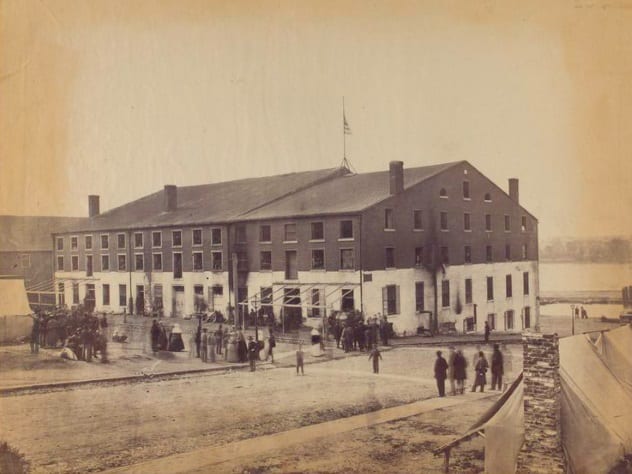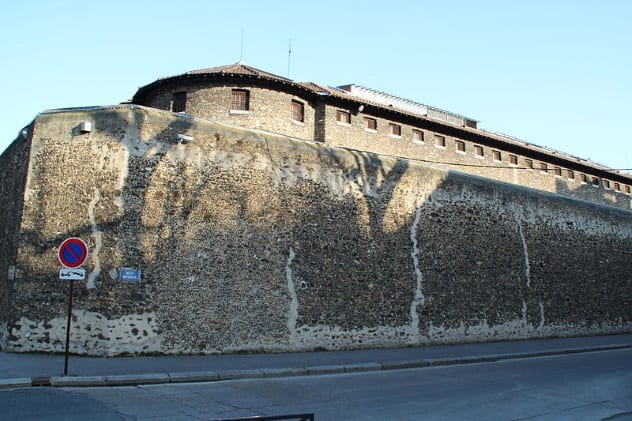 Animals
Animals  Animals
Animals  Gaming
Gaming 10 Game Characters Everyone Hated Playing
 Books
Books 10 Famous Writers Who Were Hypocritical
 Humans
Humans 10 of the World’s Toughest Puzzles Solved in Record Time
 Mysteries
Mysteries 10 Scientific Mysteries We Don’t Fully Understand
 Weird Stuff
Weird Stuff 10 Celebrities Who Have Admitted to Alien Encounters
 Our World
Our World 10 Surprising Secrets of Notre Dame Cathedral
 Miscellaneous
Miscellaneous 10 Intriguing Origins of Popular Carnival Rides
 Weird Stuff
Weird Stuff Ten Unexpected Discoveries Involving Vomit
 Movies and TV
Movies and TV 10 Actors Who Almost Didn’t Take Career-Defining Roles
 Animals
Animals 10 Amazing Animal Tales from the Ancient World
 Gaming
Gaming 10 Game Characters Everyone Hated Playing
 Books
Books 10 Famous Writers Who Were Hypocritical
Who's Behind Listverse?

Jamie Frater
Head Editor
Jamie founded Listverse due to an insatiable desire to share fascinating, obscure, and bizarre facts. He has been a guest speaker on numerous national radio and television stations and is a five time published author.
More About Us Humans
Humans 10 of the World’s Toughest Puzzles Solved in Record Time
 Mysteries
Mysteries 10 Scientific Mysteries We Don’t Fully Understand
 Weird Stuff
Weird Stuff 10 Celebrities Who Have Admitted to Alien Encounters
 Our World
Our World 10 Surprising Secrets of Notre Dame Cathedral
 Miscellaneous
Miscellaneous 10 Intriguing Origins of Popular Carnival Rides
 Weird Stuff
Weird Stuff Ten Unexpected Discoveries Involving Vomit
 Movies and TV
Movies and TV 10 Actors Who Almost Didn’t Take Career-Defining Roles
10 Inescapable Prisons People Somehow Escaped From
Prisons are all about keeping people inside, but every now and again, folks find their way out. It happens more often than you might think, but nevertheless, there are some institutions touted as being inescapable, such that there is no conceivable way for anyone to escape.
The only problem is that people inevitably do escape from those very same prisons. The ones nobody ever thought could be broken out of were, and in some cases, the daring escapes of inmates are some of the most amazing prison break stories of all time!
10 Leads Prison
Doge’s Palace, Venice, Italy, 1756

The Italian adventurer, author, and notorious playboy Giacomo Casanova was once held in the infamous Leads prison for being an affront to religion and common decency. He was placed there following his arrest on July 26, 1755, at the age of 30, but he had no intention of remaining behind bars for very long.[1] After being denied a trial or an explanation of his charges, he was sentenced to five years’ imprisonment but planned an escape via a renegade priest in an adjacent cell.
The priest used a spike from the chair in Casanova’s cell to burrow a hole in the ceiling. He crawled into it and did the same in Casanova’s, which gave him a way out. He left behind a frightened cellmate and a note saying, “I shall not die, but live, and declare the works of the Lord.” Through some rooftop acrobatics, trickery, and a fortuitously placed ladder, the pair escaped. Casanova detailed his imprisoned adventure 30 years later in his work, Story of My Flight.
9 Imrali Prison
Sea Of Marmara, Turkey, 1975

Back in the 1940s, foreign governments began cracking down on drug smugglers by imposing harsh prison sentences. Billy Hayes was a young American student when he was picked up for smuggling 1.8 kilograms (4 lb) of hashish in Turkey. Two months prior to his release, and after having served nearly four years, he learned that his sentence would be increased to life, and he was moved to a psychiatric prison hospital. Eventually, his sentence was “reduced” to 30 years, and he was moved to Imrali Prison on July 11, 1975, but he would only remain there for a few months before escaping.
On October 2, 1975, in what amounted to his fourth attempt, Hayes escaped the island prison by stealing a rowboat, which he took to Bandirma. He was able to hide with some locals before heading from there to Greece but was deported from there to Frankfurt, Germany, where he was held for a few weeks before finally gaining his freedom. Hayes wrote an account of his escape in his book, Midnight Express,[2] which was adapted into a film of the same name by Alan Parker and Oliver Stone.
8 Libby Prison
Richmond, Virginia, 1864

The Civil War fought in the United States was infamous for the terrible prison conditions present throughout both the Union and Confederate states. Andersonville in the South was well-known for the indifference it had in treating its prisoners, but nobody succeeded in escaping from that stockade. The same can’t be said for Libby Prison in Richmond, which had its only prison break in 1864, and it was a doozy! In February 1864, a total of 109 Union officers managed to escape in what became known as the Libby Prison Escape.[3]
The escape was led by Colonel Thomas E. Rose of the 77th Pennsylvania Infantry, who directed his captured subordinates to tunnel beneath the roving Confederate guards. The tunnel was dug to a length of some 15 meters (50 ft) and emerged into a vacant lot near a warehouse. Because nobody believed the prison could be escaped from, the guards barely paid any notice to the scores of men emerging through a gate in the adjacent lot. The alarm wasn’t raised for another 12 hours, leaving half of the escapees more than enough time to make it to the Union lines.
7 The Tower Of London
England, 1597

John Gerard was a Jesuit priest who worked covertly during the Elizabethan era due to the persecution placed upon the workers of the Catholic Church at that time. He was notable for being able to elude capture by English authorities for nearly a decade, but he ultimately found his way to the infamous Tower of London, where he was subjected to extensive torture for his purported crimes. The Tower is well-known as an inescapable prison which many people entered and never left, but that can’t be said for Gerard.
On the night of October 3, 1597, Gerard escaped the Tower in an incredible plot orchestrated by Nicholas Owen, a famous sainted Jesuit best known as “Little John.” With his help and others from the Catholic underground, a rope was sent up the Tower to Gerard’s location. Despite having his hands mangled from torture, he managed to climb down and cross the moat, becoming one of only a few people to manage that feat. After escaping to mainland Europe, Gerard wrote a book about his torture and escape called John Gerard: The Autobiography of an Elizabethan.[4]
6 Camp 14
North Korea, 2005

The Democratic People’s Republic of Korea, better known throughout the world as North Korea, is notorious for being one of the most authoritarian governments on the planet. Because of the structure of the dictatorship, the people have little to no rights, and those who are imprisoned end up in “work camps,” which often amount to death sentences due to the harsh conditions and lack of food. The people in these “hidden gulags” are denied to even exist by the government, and few ever leave the camps.
Shin Dong-hyuk is the only person known to be born in a prison camp, escape it, and survive to tell the world his ordeal. His whole life, he was starved, tortured, and forced to work, but worst of all, he was made to watch the execution of his mother and brother.[5] When he was 23 years old, he climbed through a high-voltage fence and escaped to China, then South Korea, and finally the United States. His amazing ordeal was documented in Blaine Harden’s book, Escape from Camp 14: One Man’s Remarkable Odyssey from North Korea to Freedom in the West.
5 The Bastille
Paris, France, 1465

The Bastille is one of the most infamous prisons in the world. It was famously stormed by a riotous crowd on July 14, 1789, in an event that is still commemorated annually as Bastille Day throughout France. The Bastille was used by the kings of France as a state prison, and it was well-known as being a place nobody could ever escape from. Despite that assertion, a very small number of people managed to escape over the centuries when luck and the conditions were just right. One such escapee was Antoine de Chabannes, Count of Dammartin.
During the reign of Louis XI, the Bastille was used as a state penitentiary. Antoine de Chabannes, the Count of Dammartin, was being held by Louis due to his membership in the League of the Public Weal, a group of nobles who defied the authority of the king. In March 1465, the count managed to escape by boat and rejoin the League.[6] Later that year, the League and the king signed the Treaty of Conflans, which put an end to the dispute between the various noblemen and the king.
4 La Sante Prison
Paris, France, 1986

Speaking of inescapable French prisons, La Sante Prison, in the east of the Montparnasse district of Paris, is one of the most infamous prisons in France, and its location puts it right inside the city limits. Since the prison went into use in 1867, there have been three escapes in total. In 1927, one man got out via a false order of release, and in 1978, a man was killed trying to escape. The real story of a daring escape from the prison came in 1986, when Michael Vaujour managed to escape with the help of his wife, Nadine.
This wasn’t one of those “back the van up to the prison wall” kind of escapes, either—it involved a helicopter. While Michael was serving a lengthy term for murder and armed robbery, Nadine Vaujour began to take flying lessons under a false name.[7] She then took a helicopter and flew it over the prison, where Michael managed to make it to a roof and cling to the skid as the helicopter flew away. He remained a free man until a gunshot to the head during a robbery months later sent him back for the next 27 years.
3 Luynnes Prison
France, 2001

It may seem crazy to learn that someone used a helicopter to escape from a prison, but it’s not as rare as you might think. In some cases, it’s simply the modus operandi for inmates like Pascal Puyet, a man who escaped from Lutnes Prison via helicopter and helped others escape twice! Luynnes Prison is a maximum-security facility located in the South of France, and while it is touted as inescapable, the truth is that it’s had several successful escapes. Puyet managed to escape via a helicopter in 2001, but that’s not the only part of the story because two years later, he broke into the prison via helicopter to help break out some of his pals![8]
Eventually, the law caught up with him again, and he was thrown back in jail. He was moved to a prison in Grasse, where he was held in solitary confinement. Thanks to Bastille Day celebrations, four of his buddies managed to hijack a helicopter, which they used to free him a third time. The men fled, leaving the pilot unharmed. Payet was finally captured (again) in Spain and remains imprisoned in a secret location somewhere in France.
2 Stalag Luft III
Poland, 1944

During World War II, the Luftwaffe ran a prisoner of war (POW) camp in Sagan, Poland, called Stalag Luft III. The camp was used to house POWs captured from Allied countries, with most coming from the United Kingdom. The site was selected due to the presence of sandy soil, which was believed to make tunneling impossible. Despite all the preparations the Germans made to the camp, a tunnel proved the best way to get out, but it required a great deal of work, stolen supplies, and a lot of secrecy among the prison population.
British prisoners managed to dig three tunnels, named Tom, Dick, and Harry, for the escape. Tom was found and destroyed by the Germans, while Dick was used to store soil and supplies. Harry became the main route of escape for 76 men who managed to crawl through the tunnel, which measured 102 meters (335 ft) long and only 0.6 meters (2 ft) square. Because of the condition of the soil, it had to be dug 9 meters (30 ft) below the surface. The escape from Stalag Luft III was depicted in the hit 1963 film The Great Escape.[9]
1 Alcatraz
San Francisco, California, 1962
 Alcatraz is well-known for being inescapable, but that’s not entirely accurate. The prison dealt with a number of escape attempts over the years, but none so infamous as the one that occurred in 1962, when John and Clarence Anglin joined up with Frank Morris to escape. The prisoners fashioned models of their heads with toilet paper, toothpaste, human hair, and concrete dust, which they placed in their bunks to make it look like they were sleeping. This fooled the guards’ night check long enough for them to make their escape.[10]
Alcatraz is well-known for being inescapable, but that’s not entirely accurate. The prison dealt with a number of escape attempts over the years, but none so infamous as the one that occurred in 1962, when John and Clarence Anglin joined up with Frank Morris to escape. The prisoners fashioned models of their heads with toilet paper, toothpaste, human hair, and concrete dust, which they placed in their bunks to make it look like they were sleeping. This fooled the guards’ night check long enough for them to make their escape.[10]
They all dug through the small opening in the back of their cells and managed to escape into a utility tunnel. From there, they snuck out of the building and made it off the island. The official word is that the three men died in the icy waters of San Francisco Bay, but there are many who believe they are still alive. There have been stories of sightings of the men over the years, all of whom would be in their late eighties or early nineties by 2019. Even if the men died, they still managed to escape from the most inescapable prison ever constructed, and their daring feat was turned into the popular Clint Eastwood film Escape from Alcatraz in 1979.
Read about more unbelievable escapes and escape artists on 10 Shockingly Daring Prison Escapes and Top 10 Inmates Who Escaped From Prison Multiple Times.








